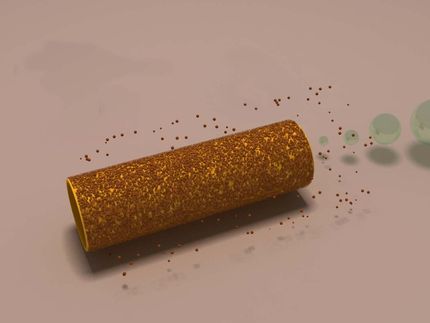New, inexpensive way to clean water from oil sands production
Researchers have developed a process to remove contaminants from oil sands wastewater using only sunlight and nanoparticles that is more effective and inexpensive than conventional treatment methods.
Frank Gu, a professor in the Faculty of Engineering at the University of Waterloo and Canada Research Chair in Nanotechnology Engineering, is the senior researcher on the team that was the first to find that photocatalysis -- a chemical reaction that involves the absorption of light by nanoparticles -- can completely eliminate naphthenic acids in oil sands wastewater, and within hours. Naphthenic acids pose a threat to ecology and human health. Water in tailing ponds left to biodegrade naturally in the environment still contains these contaminants decades later.
"With about a billion tonnes of water stored in ponds in Alberta, removing naphthenic acids is one of the largest environmental challenges in Canada," said Tim Leshuk, a PhD candidate in chemical engineering at Waterloo. He is the lead author of this paper and a recipient of the prestigious Vanier Canada Graduate Scholarship. "Conventional treatments people have tried either haven't worked or if they have worked they've been far too impractical or expensive to solve the size of the problem. Waterloo's technology is the first step of what looks like a very practical and green treatment method."
Unlike treating polluted water with chlorine or membrane filtering, the Waterloo technology is energy-efficient and relatively inexpensive. Nanoparticles become extremely reactive when exposed to sunlight and break down the persistent pollutants in their individual atoms, completely removing them from the water. This treatment depends on only sunlight for energy, and the nanoparticles can be recovered and reused indefinitely.
Next steps for the Waterloo research include ensuring that the treated water meets all of the objectives Canadian environmental legislation and regulations required to ensure it can be safely discharged from sources larger than the samples, such as tailing ponds.
Original publication
Other news from the department science
These products might interest you

NANOPHOX CS by Sympatec
Particle size analysis in the nano range: Analyzing high concentrations with ease
Reliable results without time-consuming sample preparation

Eclipse by Wyatt Technology
FFF-MALS system for separation and characterization of macromolecules and nanoparticles
The latest and most innovative FFF system designed for highest usability, robustness and data quality

DynaPro Plate Reader III by Wyatt Technology
Screening of biopharmaceuticals and proteins with high-throughput dynamic light scattering (DLS)
Efficiently characterize your sample quality and stability from lead discovery to quality control

Get the chemical industry in your inbox
By submitting this form you agree that LUMITOS AG will send you the newsletter(s) selected above by email. Your data will not be passed on to third parties. Your data will be stored and processed in accordance with our data protection regulations. LUMITOS may contact you by email for the purpose of advertising or market and opinion surveys. You can revoke your consent at any time without giving reasons to LUMITOS AG, Ernst-Augustin-Str. 2, 12489 Berlin, Germany or by e-mail at revoke@lumitos.com with effect for the future. In addition, each email contains a link to unsubscribe from the corresponding newsletter.

























































